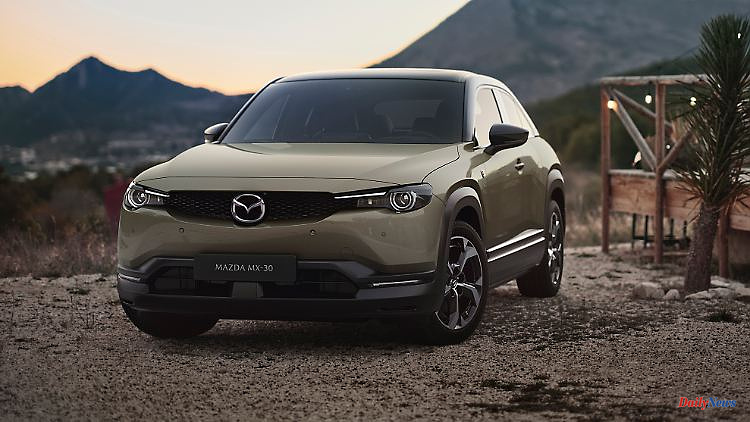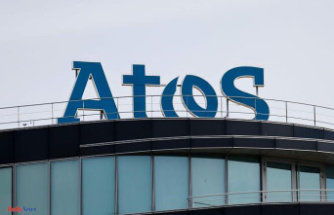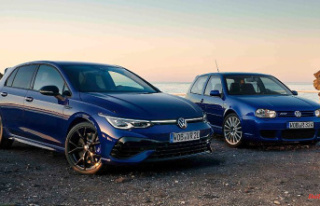Mazda is known for special technical approaches. With the second drive variant of the MX-30, the Japanese even hit two of them at the same time.
Electric car batteries are expensive, energy-intensive to produce and raw materials scarce. The Japanese car manufacturer Mazda is therefore now taking up the concept of extending the range with a gasoline-powered generator in its MX-30 e-crossover. The combination of kilowatt hours in the small battery and liters in the comparatively large tank should enable non-stop journeys of up to 600 kilometers.
The MX-30 e-Skyactiv R-EV, now presented at the Motor Show in Brussels (January 14 to 22), will be launched in the spring as an alternative to the purely electric model, which does not have an "R" in the name and does not have a combustion engine . The new variant marks a special path in two respects. The Japanese are currently the only major manufacturer to use the concept of extending the range with a combustion engine; the competition buried the so-called "range extender" years ago with reference to ever more powerful and cheaper batteries. At least the price development of the past few months could now prove Mazda right: After the kWh prices for batteries have fallen constantly and quickly for years, they recently went in the other direction again.
The R version does not have a price advantage over the battery-only model - both cost at least 36,000 euros. The 125 kW/170 hp newcomer is superior to the old one, except for the power (107 kW/145 hp) but the overall range. It consists of 85 kilometers of emission-free e-driving and more than 500 kilometers of driving in which the petrol engine takes over the power supply as a generator. There is no direct connection between the combustion engine and the wheels - but there are local CO2 emissions.
Thanks to the larger battery (32 kWh instead of 17.8 kWh), the purely electric MX-30 has a range of 200 kilometers according to the standard - a fairly weak value in the current competitive environment, which also has an impact on the popularity of the elegant and formally quite successful crossover. The new variant is intended to make the MX-30 attractive beyond its use as a second car or purely as a city car. However, she cannot rely on the help of the e-car premium: since there is a combustion engine on board, the crossover does not qualify for the state subsidy.
After all, there are advantages in company car taxation, which still applies to plug-in hybrids. That's what Mazda calls the system itself, even if it differs technically from the drives that are commonly called that. Because with them, a relatively large combustion engine also drives the wheels directly. However, the MX-30 drive does not pass as a classic range extender electric car in the legal sense, since the tank with 50 liters is clearly too large for it.
The terminological imprecision in the designation of the drive is difficult to avoid. Technically closest to the Mazda are the competitors Opel Ampera (2012 to 2016) and BMW i3 Range Extender (2013 to 2018). More recent examples of such a combination of combustion engine and electric drive only exist in Europe in the form of the Ford Transit or Tourneo Custom, which has only existed in one division since its launch at the beginning of the decade.
The Mazda differs from its competitors not only by the larger fuel tank but also by the choice of the internal combustion engine, which serves as a generator. Instead of a reciprocating engine, the Japanese use a rotary piston or Wankel engine. The technology, which is otherwise only used in mass production in the Audi predecessor NSU, has a long tradition at Mazda and was used in numerous models of the brand up until 2012.
The Wankel is well suited for working as a power generator, as it is very compact and also extremely smooth-running. In the MX-30, a small single-disc variant - comparable to a one-cylinder piston engine - is used, which has a displacement of 0.83 liters and 55 kW/75 hp and takes up space in the engine compartment with the 125 kW/170 hp E-unit and the electric generator shares. The manufacturer states that the total consumption for 100 kilometers is 1 liter of fuel plus 17.5 kWh of electricity.
When it comes to charging technology, the new drive variant is only partially based on its sister model. The AC wall box charges with up to 11 kW, direct current flows into the battery with a maximum of 36 kW. The larger battery of the pure Stromer can handle 50 kW. Mazda specifies 25 minutes (20 to 80 percent) as the charging time on the fast charger, and the wallbox is over after 1 hour 40 minutes in the best case.
The R-EV will initially be available in five equipment lines. The "Prime Line" basic variant, which costs 35,990 euros, should be based on the purely electric model and offer, among other things, 18-inch rims, a rear view camera and a navigation system. The highest level is called "Edition R" and is intended to celebrate the return of the "Rotary Engine", the rotary piston engine. In addition to a Bose sound system and 360-degree camera, it offers, among other things, effect paint, a glass sunroof and various R logos for 45,040 euros.












